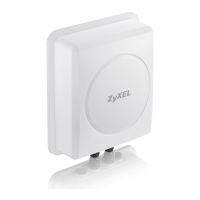Chapter 8 Network Address Translation (NAT)
LTE7410 User’s Guide
58
Note: Many residential broadband ISP accounts do not allow you to run any server
processes (such as a Web or FTP server) from your location. Your ISP may
periodically check for servers and may suspend your account if it discovers any
active services at your location. If you are unsure, refer to your ISP.
Configuring Servers Behind Port Forwarding (Example)
Let's say you want to assign ports 21-25 to one FTP, Telnet and SMTP server (A in the example),
port 80 to another (B in the example) and assign a default server IP address of 10.0.0.35 to a third
(C in the example). You assign the LAN IP addresses and the ISP assigns the WAN IP address. The
NAT network appears as a single host on the Internet.
Figure 41 Multiple Servers Behind NAT Example
8.3.1 The Port Forwarding Screen
Click Network Setting > NAT to open the Port Forwarding screen.
Figure 42 Network Setting > NAT > Port Forwarding
The following table describes the fields in this screen.
A=10.0.0.33
D=10.0.0.36
C=10.0.0.35
B=10.0.0.34
WAN
LAN
10.0.0.1
IP Address assigned by ISP
Table 16 Network Setting > NAT > Port Forwarding
LABEL DESCRIPTION
WAN Interface Select the WAN interface for which to configure NAT port forwarding rules.
Add new rule Click this to add a new port forwarding rule.
# This is the index number of the entry.
Active This field indicates whether the rule is active or not.
A yellow bulb signifies that this rule is active. A gray bulb signifies that this rule is not
active.

